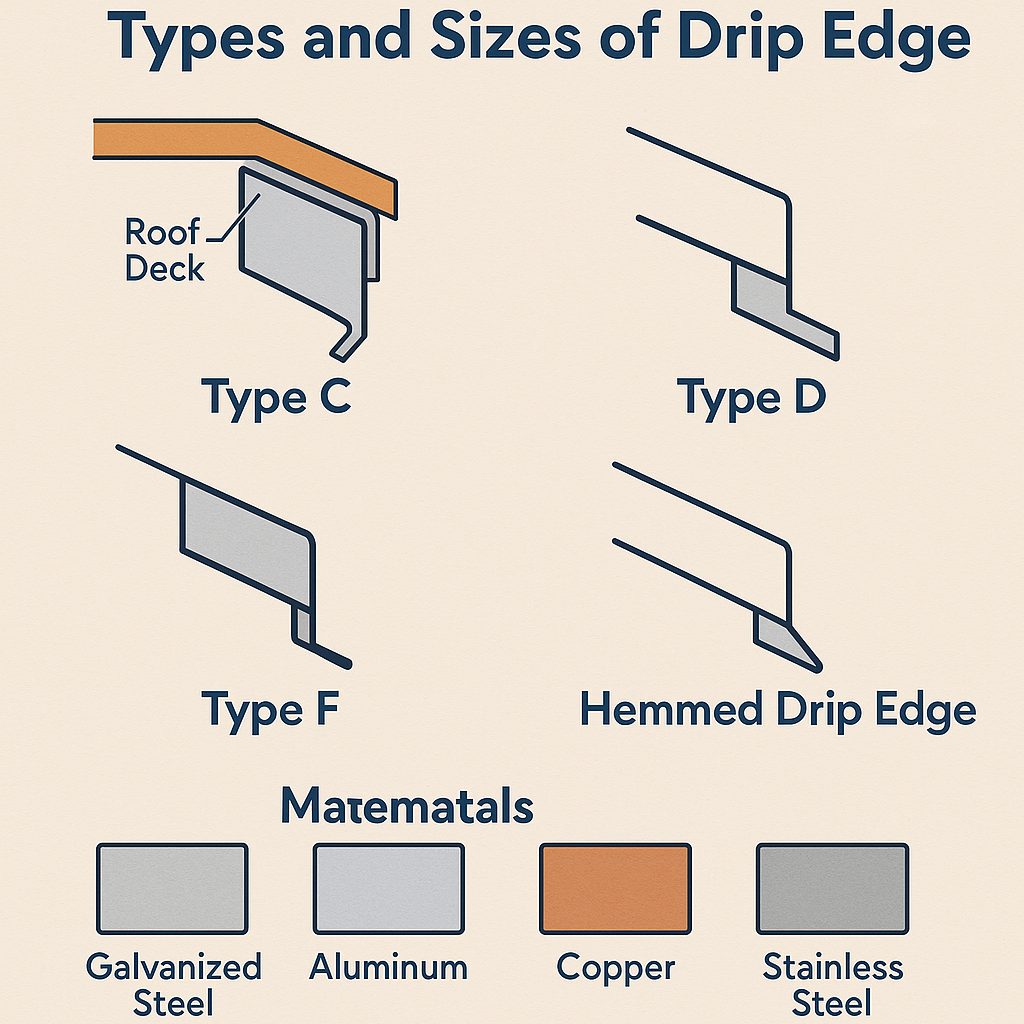
Posted on Friday, May 23, 2025
A drip edge is a metal flashing installed at the edges of a roof to direct water away from the fascia and underlying roofing components. It helps protect the building from water damage, rot, and pest intrusion by ensuring that runoff flows into the gutters and away from the structure.
Drip edges are a standard in both residential and commercial roofing systems and are often required by building codes in North America and other regions due to their role in prolonging roof life.
Moisture Protection: Prevents water infiltration under shingles or roofing panels.
Fascia Protection: Shields wooden fascia boards from water staining and rot.
Gutter Efficiency: Ensures water flows directly into the gutter system.
Aesthetic Finish: Offers a clean, finished look to the roofline.
Drip edge profiles vary based on regional preferences, building codes, and roofing materials. The most common types include:
Resembles a 90-degree angle.
Common in older homes.
Simple to install.
Features a flange that kicks water away from the fascia.
Offers better water redirection than Type C.
Most popular for modern roofing systems.
Extends further back on the roof deck.
Ideal for reroofing and drip edge replacement.
Rolled edge for added safety and strength.
Often used in commercial metal roofing.
Designed for specific architectural or industrial applications.
Often made using roll forming machines tailored to unique sizes.
Different environments and roof types require specific materials. Common materials include:
| Material | Benefits | Typical Uses |
|---|---|---|
| Galvanized Steel | Durable, rust-resistant (if coated) | Residential, commercial buildings |
| Aluminum | Lightweight, corrosion-resistant | Coastal homes, metal roofs |
| Copper | Elegant, durable, naturally patinas | High-end residential, historic renovations |
| Stainless Steel | Corrosion-proof, high tensile strength | Industrial, chemical, coastal applications |
| Painted Steel | Aesthetic and rust protection | Residential roofing with colored panels |
Typical drip edge dimensions:
Vertical leg (fascia drop): 1" to 4"
Roof flange (under-shingle): 2" to 5"
Drip kick-out lip: ¼" to ½"
Material thickness (gauge):
Aluminum: 0.019" to 0.032"
Steel: 24 to 30 gauge
Copper: 16 to 20 oz
Larger and custom sizes are available through manufacturers or on-site fabrication.
Drip edges aren’t just for residential homes. They're used in:
Residential construction
Commercial buildings
Modular and prefab housing
Warehouses and industrial roofs
Agricultural buildings
Container conversions
Solar panel sheds and outbuildings
Roofing nails or screws
Roofing cement or sealant (if required)
Tin snips
Hammer or drill
Chalk line
Measuring tape
Install underlayment: Place roofing underlayment across the roof deck.
Install eaves drip edge: Start at the eaves. Place the drip edge with the flange extending away from the fascia. Nail every 8–10 inches.
Install side rake edge: Overlap the rake edge over the eave drip edge. This ensures proper water runoff.
Seal overlaps: Where sections meet, overlap by 1–2 inches. Seal joints if in a high wind or ice-prone area.
Add shingles or roofing panels: Install roofing over the drip edge flange for best protection.
When selecting a drip edge, consider:
Climate: Use aluminum or stainless steel in coastal zones.
Roof type: Type D or F for steep-slope or metal roofs.
Color and aesthetics: Painted or copper drip edges for visible applications.
Building codes: Always check local requirements (e.g., IRC in the U.S.).
Here are notable U.S.-based manufacturers:
ABC Supply Co., Inc.
Amerimax Building Products
Petersen Aluminum (PAC-CLAD)
Fabral
MBCI (Metal Building Components Inc.)
Englert Inc.
Rollex
Metal Sales Manufacturing Corporation
Westlake Royal Building Products
TAMKO Building Products
CertainTeed
Gibraltar Industries
Mid-America Siding Components
Union Corrugating
Berger Building Products
Berridge Manufacturing Company
Firestone Building Products (now part of Holcim)
ATAS International
Georgia-Pacific Building Products
Mule-Hide Products Co., Inc.
Kingspan Group (Ireland)
ArcelorMittal Construction (Global)
Ruukki (Finland)
Tata BlueScope Steel (India/Australia)
Metecno Group (Italy/Global)
Blachotrapez (Poland)
Lindab (Sweden)
Swisspearl Group (Switzerland)
Isopan (Italy)
Dongkuk Steel (South Korea)
CSM Metal Deck (Thailand)
Zamil Steel (Saudi Arabia)
JSW Steel (India)
Shandong Goldensun Steel (China)
Dongbu Steel (South Korea)
Xiamen Liming Machinery Co., Ltd. (China)
SAF – Southern Aluminum Finishing (USA/Global)
VMZinc (France)
Marcegaglia (Italy)
Jindal Steel & Power (India)
Modern roll forming machines produce precision drip edges at high speed using:
GCr15 hardened rollers
Servo-feeding and punching units
Automated shearing and stacking systems
Machine Matcher offers customized drip edge roll forming machines tailored to your profile needs—designed for aluminum, steel, copper, and painted coils.
A: Yes. It prevents water damage, extends the life of your roof, and is often required by building codes.
A: Yes, but it’s more challenging. A Type F (gutter apron) is recommended for retrofits.
A: Aluminum or stainless steel due to their corrosion resistance.
A: Yes. Many drip edges come pre-painted to match the roof or trim.
Whether you're a contractor, architect, or metal fabricator, choosing the right drip edge is critical for roof integrity. Machine Matcher connects you with drip edge roll forming machines and global suppliers to match your material, profile, and production needs.

Most Popular Roll Forming Machines in the United Kingdom
Posted on Thursday, December 11, 2025
This blog breaks down the five most in-demand roll forming machines in the UK

Can I Finance a Roll Forming Machine?
Posted on Thursday, December 11, 2025
Financing a roll forming machine is easier than most buyers think. Here’s how leases, loans, and payment plans make production affordable.

Roll Forming Machines for Sale in the UK: What Buyers Need to Know Before Purchasing
Posted on Thursday, December 11, 2025
This complete guide explains everything UK buyers must know before purchasing, including machine types, voltage requirements, CE/UKCA compliance

Roll Forming Machines for Sale in the USA: What Buyers Need to Know Before Purchasing
Posted on Wednesday, December 10, 2025
This guide explains everything U.S. buyers need to know before purchasing a roll forming machine, including machine types, pricing, voltage
Copyright 2026 © Machine Matcher.